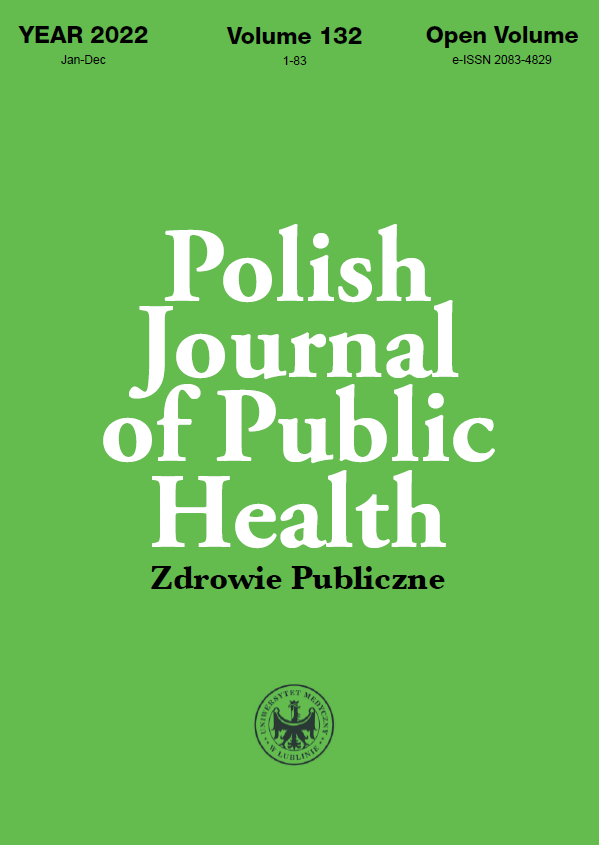Occurrence and applied interventions in Work-Related Musculoskeletal Disorders among medical workers – review
DOI:
https://doi.org/10.2478/pjph-2022-0016Keywords:
musculoskeletal disorders, medical workers, occupational diseasesAbstract
Introduction. Ailments resulting from work-related musculoskeletal disorders (WRMSD) are currently a large social problem that is widely studied both in Poland and in the world in the context of preventive measures. WRMSD are one of the main causes of dysfunction or injuries, resulting in absenteeism and even disability. The professional group of medical workers is currently one of the most exposed to the occurrence of occupational-related musculoskeletal disorders, right after the construction and, agricultural and fishing sectors.
Aim. The aim of the study is to present the problems of musculoskeletal disorders and various interventions to prevent this disease in medical professions.
Material and methods. The authors undertook the analysis of the subject matter due to the increasing number of musculoskeletal disorders and occupational diseases in medical groups. The authors obtained articles from reputable databases: PubMed and Embase.
Results. The results of the analyzed studies clearly indicate an increasing frequency of musculoskeletal disorders among medical workers, higher in increasingly younger age groups. The dominant symptoms include muscle pain in the neck area, upper and lower back, shoulder and knee joints, as well as numerous overload syndromes.
Conclusion. Kinesiology programs significantly reduce the incidence of WRMSD and also injuries, they reduce pain and the use of drugs. The most common types of intervention include: consultation with therapists in preventive programs and work ergonomics training.
Continuous and multidirectional research on the issues of WRMSD is necessary due to their more frequent occurrence and the lack of effective system solutions in the field of their prevention and treatment.
References
1. Kok de J, Vroonhof P, Snijders J, et al. Work-related musculoskeletal disorders: prevalence, costs and demographics in the EU. Proceedings of the European Agency for Safety and Health at Work. Luxembourg; 2019.
2. Bugajska J, Jędryka-Góral A, Gasik R, et al. Nabyte zespoły dysfunkcji układu mięśniowo-szkieletowego u pracowników w świetle badań epidemiologicznych. Med Pr. 2011;62:153-61.
3. Jurgilewicz O. Stres i stresory w pracy wpływające na poczucie bezpieczeństwa pracown ika. MMR. 2017;24(4/2017):59-71.
4. Bahar S, Haight A, Maluf K. Differential effects of mental concentration and acute psychosocial stress on cervical muscle activity and posture. J Electromyogr Kinesiol. 2013;23,5:1082-9. doi:10.1016/j.jelekin.2013.05.009.
5. Eijckelhof BH, Huysmans MA, Bruno Garza JL, et al. The effects of work-place stressors on muscle activity in the neck-shoulder and forearm muscles during computer work: a systematic review and meta-analysis. Eur J Appl Physiol. 2013;113(12):2897-912.
6. Søgaard K, Blangsted AK, Nielsen PK, et al. Changed activation, oxygenation, and pain response of chronically painful muscles to repetitive work after training interventions: a randomized controlled trial. Eur J Appl Physiol. 2012;12(1):173-81.
7. Lindegård A, Larsman P, Hadzibajramovic E, et al. The influence of perceived stress and musculoskeletal pain on work performance and work ability in Swedish health care workers. Int Arch Occup Environ Health. 2014;87(4):373-9.
8. Marshall L, Villeneuve J, Grenier S. Effectiveness of a multifactorial ergonomic intervention and exercise conditioning kinesiology program for subsequent work related musculoskeletal disorder prevention. Work. 2018;61(1):81-9.
9. Marker RJ, Campeau S, Maluf KS. Psychosocial stress alters the strength of reticulospinal input to the human upper trapezius. J Neurophysiol. 2017;117(1):457-66.
10. Wixted F, O’Riordan C, O’Sullivan, L. Inhibiting the physiological stress effects of a sustained attention task on shoulder muscle activity. IJERPH. 2018;15(1):115.
11. Giagio S, Volpe G, Pillastrini P, et al. A Preventive program for work-related musculoskeletal disorders among surgeons: Outcomes of a randomized controlled clinical trial. Ann Surg. 2019;270(6):969-75.
12. Dabholkar T, Yardi S, Dabholkar YG, et al. A survey of work-related musculoskeletal disorders among otolaryngologists. Indian J Otolaryngol Head Neck Surg. 2017;69(2):230-8.
13. Sharan D, Rajkumar JS, Balakrishnan R. Work Related Musculoskeletal Disorders among orthopaedic surgeons: a survey study. Occup Environ Med. 2018;75(Suppl 2):A1-A650.
14. Sharan D, Rajkumar JS, Balakrishnan R. Risk Factors for Work Related Musculoskeletal Disorders among physiotherapists. BMJ Publishing Group Ltd.; 2018.
15. Gupta D, Bhaskar DJ, Gupta KR, et al. Use of complementary and alternative medicine for work related musculoskeletal disorders associated with job contentment in dental professionals: Indian outlook. Ethiop J Health Sci. 2014;24(2):117-24.
16. Saleem M, Tanveer F, Ahmad A. Correlation between shoulder pain and functional disability among nurses. Rawal Med J. 2018;43:483-5.
17. Fátima D, Serranheira F. Prevalência de sintomas associados a lesões musculoesqueléticas na atividade profissional dos higienistas orais. Revista Portuguesa de Saúde Pública. 2015;33(1):49-56.
18. Parul RA, Girish N. Lower quadrant dysfunctions among dentists – prevalence and risk factors. J Musculoskeletal Res. 2013;16(4):1350021.
19. Evans K, Roll S, Baker J. Work-Related Musculoskeletal Disorders (WRMSD) among registered diagnostic medical: Sonographers and vascular technologists: A representative sample. JDMS. 2009;25:287.
20. Larsen AK, Thygesen LC, Mortensen OS, et al. The effect of strengthening health literacy in nursing homes on employee pain and consequences of pain ‒ a steppedwedge intervention trial. Scand J Work Environ Health. 2019;45(4):386-95.
21. Neves M, Serranheira F. A formação de profissionais de saúde para a prevenção de lesões musculoesqueléticas ligadas ao trabalho a nível da coluna lombar: uma revisão sistemática: Revista Portuguesa de Saúde Pública, 2014;32(1):89-105.
Downloads
Published
Issue
Section
License
Copyright (c) 2023 Authors

This work is licensed under a Creative Commons Attribution-NonCommercial-NoDerivatives 3.0 Unported License.


